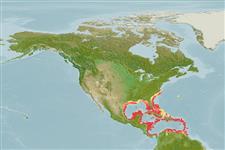>
Eupercaria/misc (Various families in series Eupercaria) >
Lutjanidae (Snappers) > Lutjaninae
Etymology: Lutjanus: Malay, ikan lutjan, name of a fish.
More on author: Cuvier.
Environment: milieu / climate zone / depth range / distribution range
Ecologia
marinhas associadas(os) a recifes; intervalo de profundidade 0 - 100 m (Ref. 36484). Subtropical; 36°N - 9°N, 99°W - 59°W (Ref. 55233)
Western Atlantic: North Carolina, USA to northeastern Brazil (Ref. 57756), including the Gulf of Mexico (Ref. 9626). Common around the Caribbean.
Tamanho / Peso / Idade
Maturity: Lm ? range ? - ? cm
Max length : 48.0 cm TL macho/indeterminado; (Ref. 55); common length : 38.0 cm TL macho/indeterminado; (Ref. 55); peso máx. Publicado: 1.3 kg (Ref. 26340); Idade máx. registada: 18 anos (Ref. 115050)
Espinhos dorsais (total) : 10; Raios dorsais moles (total) : 11 - 12; Espinhos anais: 3; Raios anais moles: 8. Lower jaw projecting slightly beyond upper jaw; lower corner of preopercle greatly projecting and strongly serrated. Preorbital bone broad, maxilla extending nearly to mid-eye level. Preopercular notch and knob moderate. Scale rows on back rising obliquely above lateral line. Back and upper side gray to dark olive grading to silvery ventrally. Usually with a black spot, about eye size, on lateral line below the anterior soft dorsal-fin rays.
Adults inhabit clear shallow waters over rocky bottoms in the vicinity of coral reefs, less frequently in sandy or seagrass areas. They often form large aggregations during the day. They feed at night mainly on small fish, shrimps, crabs and cephalopods (Ref. 78464).
Life cycle and mating behavior
Maturidade | Reprodução | Desova | Ovos | Fecundidade | Larvas
Allen, G.R., 1985. FAO Species Catalogue. Vol. 6. Snappers of the world. An annotated and illustrated catalogue of lutjanid species known to date. FAO Fish. Synop. 125(6):208 p. Rome: FAO. (Ref. 55)
Categoria na Lista Vermelha da IUCN (Ref. 130435: Version 2024-2)
Ameaça para o homem
Reports of ciguatera poisoning (Ref. 30303)
Utilização humana
Pescarias: espécies comerciais; peixe desportivo: sim
Ferramentas
Relatórios especiais
Descarregue XML
Fontes da internet
Estimates based on models
Preferred temperature (Ref.
123201): 23.9 - 28, mean 26.6 °C (based on 232 cells).
Phylogenetic diversity index (Ref.
82804): PD
50 = 0.5000 [Uniqueness, from 0.5 = low to 2.0 = high].
Bayesian length-weight: a=0.01738 (0.00966 - 0.03125), b=2.95 (2.80 - 3.10), in cm total length, based on LWR estimates for this species & Genus-body shape (Ref.
93245).
Nível Trófico (Ref.
69278): 4.3 ±0.4 se; based on diet studies.
Generation time: 11.3 ( na - na) years. Estimated as median ln(3)/K based on 2
growth studies.
Resiliência (Ref.
120179): Baixo, tempo mínimo de duplicação da população 4,5 - 14 anos (K=1).
Fishing Vulnerability (Ref.
59153): High vulnerability (64 of 100).
Nutrients (Ref.
124155): Calcium = 19.4 [10.5, 31.8] mg/100g; Iron = 0.329 [0.197, 0.581] mg/100g; Protein = 19 [18, 20] %; Omega3 = 0.208 [0.126, 0.343] g/100g; Selenium = 28.1 [13.7, 51.9] μg/100g; VitaminA = 174 [31, 851] μg/100g; Zinc = 0.272 [0.192, 0.417] mg/100g (wet weight);
